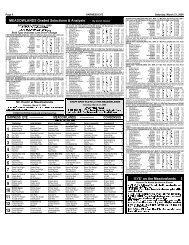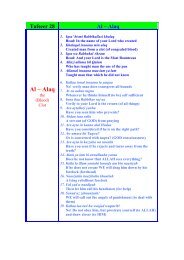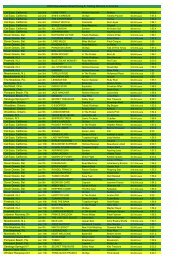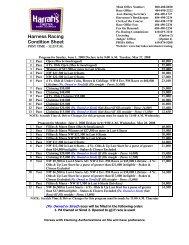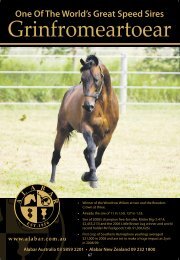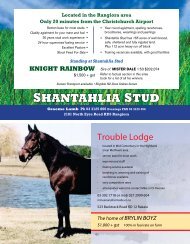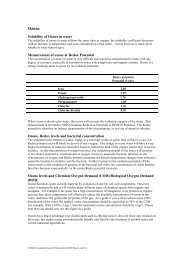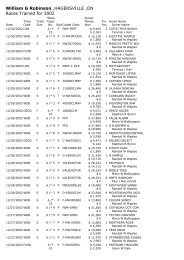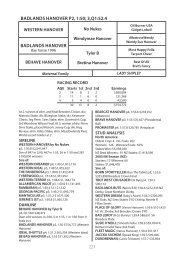Stallions - Harnesslink
Stallions - Harnesslink
Stallions - Harnesslink
You also want an ePaper? Increase the reach of your titles
YUMPU automatically turns print PDFs into web optimized ePapers that Google loves.
Equine vaccination programmes may differ greatly due to the<br />
animal’s geographic location, risk to potential disease, age<br />
or type, e.g. a race horse, brood mare, foal, or a pleasure<br />
horse.<br />
Listed below is the range of vaccinations in common use on<br />
New Zealand stud farms.<br />
It should be clearly emphasized that these are only guidelines.<br />
Your veterinarian, taking into account potential risk factors,<br />
will be able to determine what vaccination programme is most<br />
appropriate for your horses.<br />
BROODMARES<br />
Equine vaccination programmes for New Zealand<br />
Broodmares are primarily vaccinated to protect the foal either<br />
in-utero and also to convey passive immunity via colostrum in<br />
the first months of the foal’s life before they have a mature<br />
immune system.<br />
Equine Herpes Virus Abortion: Vaccination is an aid in<br />
the prevention of EHV-1 induced abortion. Two vaccines<br />
are available in NZ: Pneumabort –K+1b and Pneumequine.<br />
The manufacturers’ vaccination programmes need to be<br />
followed to give protection to the pregnancy in the face of a<br />
challenge.<br />
Tetanus: pregnant mares are given a booster vaccination prior<br />
to foaling to increase the protection provided to the foal via<br />
the mare’s colostrum (first milk).<br />
Following a wound or surgery tetanus antitoxin Equivac TAT<br />
should be given to provide immediate short-term protection<br />
against tetanus, especially where there is no evidence of a<br />
vaccination history.<br />
Salmonellosis: Annual vaccination of pregnant mares against<br />
Salmonella typhimurium is given prior to foaling to increase<br />
the protection provided to the foal via the mare’s colostrum<br />
(first milk).<br />
Strangles: Vaccination of pregnant mares against strangles<br />
is usually given in conjunction with tetanus using Equivac 2<br />
in 1.<br />
Often the vaccination programme of the pregnant mare is the<br />
combination of the three (salmonella, tetanus and strangles)<br />
administered together with an all purpose wormer which has<br />
praziquantel for tapeworms. Tapeworms have been implicated<br />
as a cause of colic in late pregnancy.<br />
Equine Rotavirus: This virus is sporadic in its incidence in NZ.<br />
Passive transfer of immunity via the colostrum provides young<br />
suckling foals protection from rotavirus enteritis. Duvaxyn R<br />
is used to vaccinate pregnant mares on farms with a history<br />
of the disease.<br />
31<br />
YOUNG ANIMALS<br />
Salmonellosis: This is probably the most impor tant<br />
vaccination from the point of view of disease incidence. Young<br />
animals with it will die. Vaccination should take place between<br />
three and five months of age according to the vaccination<br />
programme recommended by the manufacturer.<br />
Tetanus: Generally the foal’s primary vaccination course of<br />
tetanus toxoid starts around weaning time (five to six months<br />
of age). If the vaccination status of the mare is not known<br />
vaccination may commence earlier. Vaccination consists of<br />
two doses of Equivac T or Equivac 2 in 1 administered four<br />
weeks apart. A third dose of tetanus vaccine is given a year<br />
later to confer long lasting immunity. For ongoing protection<br />
a booster is required every four to five years.<br />
Following a wound or surgery tetanus antitoxin Equivac TAT may<br />
be given to provide immediate short-term protection against<br />
tetanus in the young animal or where there is no evidence<br />
of a vaccination history. Antitoxin can be administered in co-<br />
junction with toxoid if indicated.<br />
Strangles: Generally the primary vaccination course would<br />
start at weaning. The commonly used vaccines are Equivac<br />
S and Equivac 2 in 1 (an intranasal vaccine). Equivac S or<br />
Equivac 2 in 1 can be administered from 12 weeks of age<br />
with the second and third vaccinations each two weeks apart.<br />
A booster vaccination is required annually or more frequently<br />
in high-risk situations.<br />
The modified-live vaccine Pinnacle IN is a third option, it is<br />
administered via a special applicator tip into one nostril. This<br />
approach stimulates mucosal immunity at the site of natural<br />
infection. Two doses of Pinnacle IN are administered two<br />
to three weeks apart regardless of any previous injectable<br />
strangles vaccines.<br />
EHV Respiratory Infection: For reduction in severity of<br />
clinical signs of respiratory disease caused by EHV1 and 4<br />
Duvaxyn EHV 1,4 as prescribed.<br />
EXPORTED HORSES<br />
Equine Influenza and Encephalomyelitis: Yearlings and<br />
other horses sold for export to the Northern Hemisphere<br />
and South Africa require vaccination prior to transit. Fluvac<br />
Innovator-4 combines equine encephalomyelitis eastern and<br />
western viruses with equine influenza types A1 and A2 and<br />
tetanus in one vaccination. Two doses of Fluvac Innovator-<br />
4 are given two to four weeks apart. The first dose is given<br />
prior to transit and the second dose is administered in the<br />
country of destination. This vaccine is only available to be<br />
administered to horses being exported.<br />
All vaccination programmes should be administered according to the<br />
manufacturer’s directions under the authority of a veterinarian.<br />
Pacificvet Limited, 3 Hickory Place, Christchurch 8042



